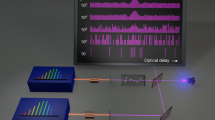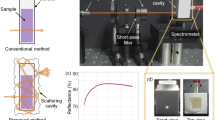Abstract
IN 1895 Merritt,1 observing the infra-red absorption in the 2.9μ region of a beam passing at right angles to the axis in crystalline quartz, found a definite difference when the radiation was polarised in planes at right angles and parallel to the axis. That is, the ordinary and extraordinary rays respectively were differently absorbed. The absorption of a beam parallel to the axis was, as was to be expected, similar to that of the ordinary ray in the first case. Koenigsberger2 in 1897 made like observations.
This is a preview of subscription content, access via your institution
Access options
Subscribe to this journal
Receive 51 print issues and online access
$199.00 per year
only $3.90 per issue
Buy this article
- Purchase on Springer Link
- Instant access to full article PDF
Prices may be subject to local taxes which are calculated during checkout
Similar content being viewed by others
References
Ann. Phys., 55, 49; 1895.
Ann. Phys., 61, 687; 1897.
Z. Phys., 42, 426; 1927.
Phys. Rev., 39, 562; 1932.
Author information
Authors and Affiliations
Rights and permissions
About this article
Cite this article
DRUMMOND, D. Infra-Red Absorption of Quartz. Nature 130, 928–929 (1932). https://doi.org/10.1038/130928b0
Issue Date:
DOI: https://doi.org/10.1038/130928b0
Comments
By submitting a comment you agree to abide by our Terms and Community Guidelines. If you find something abusive or that does not comply with our terms or guidelines please flag it as inappropriate.



